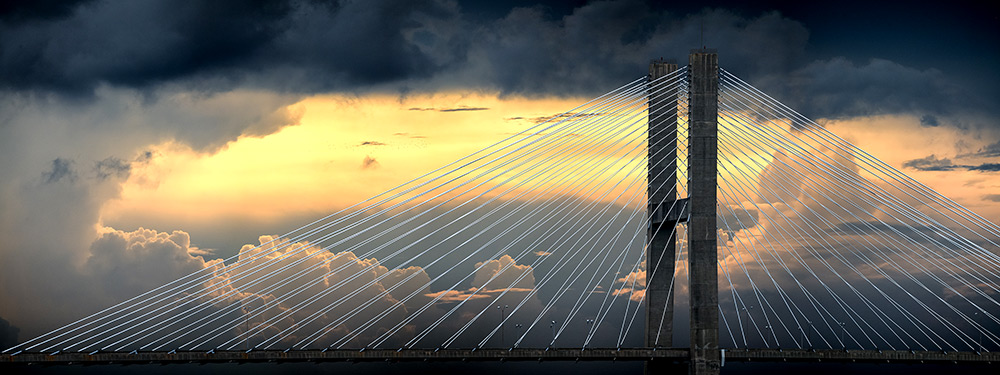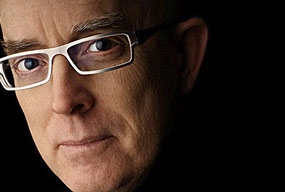One Shot: The Bridge
The Talmadge Memorial Bridge, Savannah, Georgia, in a window of sudden sunlight. D850, AF-S NIKKOR 80-400mm f/4.5-5.6G ED VR (at 400mm), 1/2000 second, f/8, ISO 800, manual exposure, Matrix metering. Ten vertical frames were merged using Adobe Lightroom and Photoshop to create the panoramic composite.
Until the cops showed up, Mark Alberhasky's pursuit of a picture of the Talmadge Memorial Bridge in Savannah, Georgia, was going quite well.
Mark had driven down from Atlanta to visit a friend and take the picture, and as he drove into Savannah, everything was falling into place, as near downtown the road rose to remove distracting backgrounds. Great, he thought; this is the angle I need to get the high-impact picture I want.
Then it got even better: at the top of the overpass rise, at the exact spot he needed to be, where he could stand, set up his tripod and shoot the bridge again an open sky, a 20-foot section of tall safety fencing was missing. He had the opening he needed. He noted the time and knew exactly when to be there tomorrow, ready to shoot.
The next day he enlisted his friend's help. The deal was, "Just pull up, I'll hop out, you drive away, and if you come back in 15 or 20 minutes, it'll be a wrap."
But...well, Mark tells it best:
"I hadn't even opened my tripod when two police cars pull up. Cops jump out, and one officer says, 'What are you doing here, sir?' I say, 'I'm taking a picture of the bridge,' and she says, 'I understand you want to shoot the bridge, but you can't be here,' and I'm like, 'Wait a minute—this is a sidewalk intended for pedestrians, I'm not blocking traffic, why can't I be here?' She says, 'Well, it's not that you want to shoot the bridge, it's that right beneath you, if you look down, is the Port of Savannah, and you can't photograph the Port of Savannah.' I'm tempted to ask them to just stand there with me—I'd take the shot, and they could clearly see what was on my LCD, but I realize they surely have better things to do." At that point, Mark's friend, who'd seen what was going on, drove up, he got in and away they went. "Of course I was disappointed," Mark says. "I was convinced that was the spot for the best shot."
Obviously he was not familiar with a local old saying: "A friend familiar with Savannah is a friend indeed."
And so he soon finds himself at a rooftop bar on the opposite side of the bridge. "It gave me more of a broadside view of the bridge," Mark says, "but the sky was getting darker, kind of overcast, and I wasn't bullish on the conditions, but hey, I'm up here, I'm going to shoot it. But from a broadside view I wasn't going to be able to show both spans and get the kind of impact shot I'd wanted, so I pick the span section I can get an angle on, with cables coming up one side and down the other, and I'm thinking rule of thirds, the span off-center and a multi-frame panorama. I shot it, and that was that."
Not quite.
"As we're sitting there eating dinner, a window opens in the overcast sky and the sunlight of the approaching sunset comes through, and it's like, Oh, man, look at that light! That's the shot!"
He re-shoots, and although he knows what he's got, it isn't until he gets the images on the computer that he realizes the full impact. "I had no idea how they were going to explode with light in the fame."
His post-production included a lot of cable repair. The bridge image is a panorama comprised of ten separate vertical frames, and when the images were merged, he had to manually align the cables.
When we spoke to Mark we learned that the experience of making the image recalled something he'd learned years ago.
"I was self-taught in photography," he says, "and when I was thinking of becoming a full-time professional, I knew I had a lot of stuff to learn. The first thing I did was take a lighting workshop with Joe McNally, and as much as it opened my eyes to lighting, the thing that stuck with me was about Joe: he never gives up. He knows where he wants to go, and he'll work at it until the obstacles in his way are no longer there. But sometimes that means the best shot isn't the one he started out to make."
The Savannah police officer was right: Mark shouldn't have been at that spot. The high-impact image he wanted was waiting for him across town.







